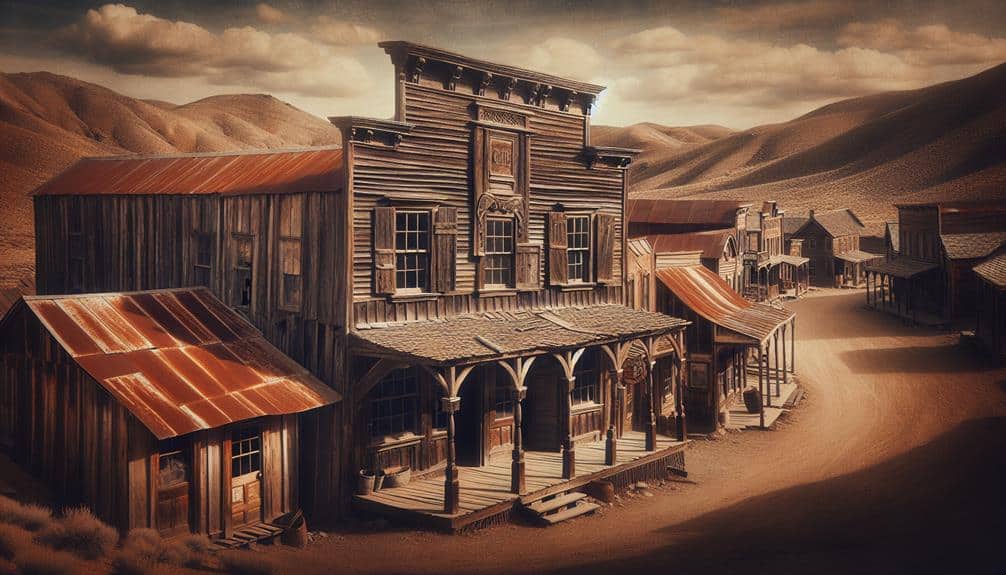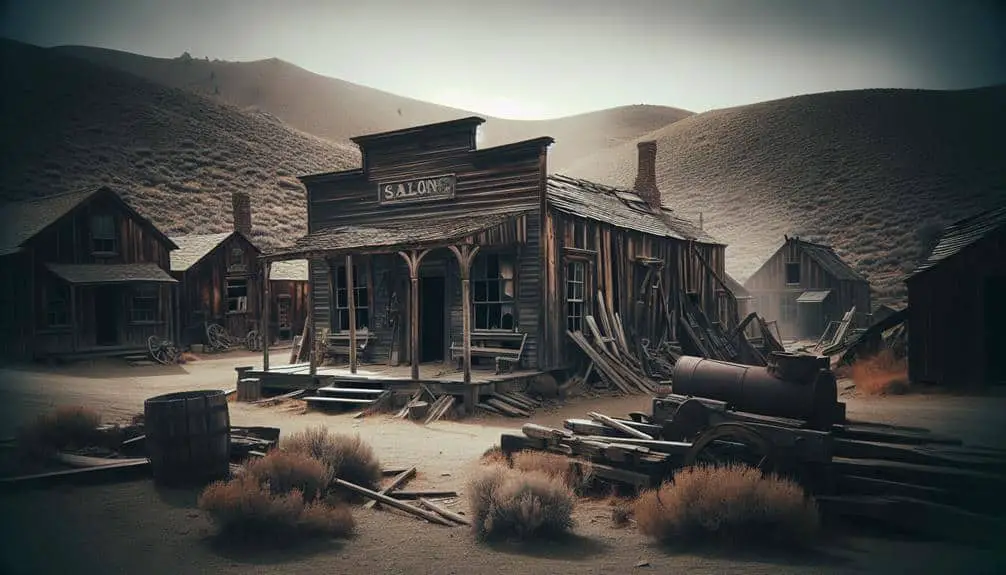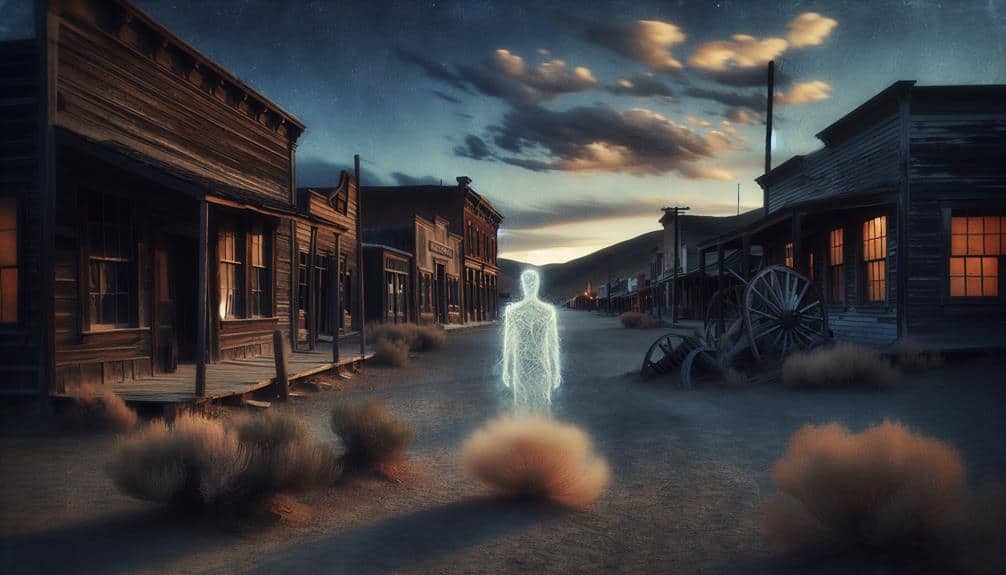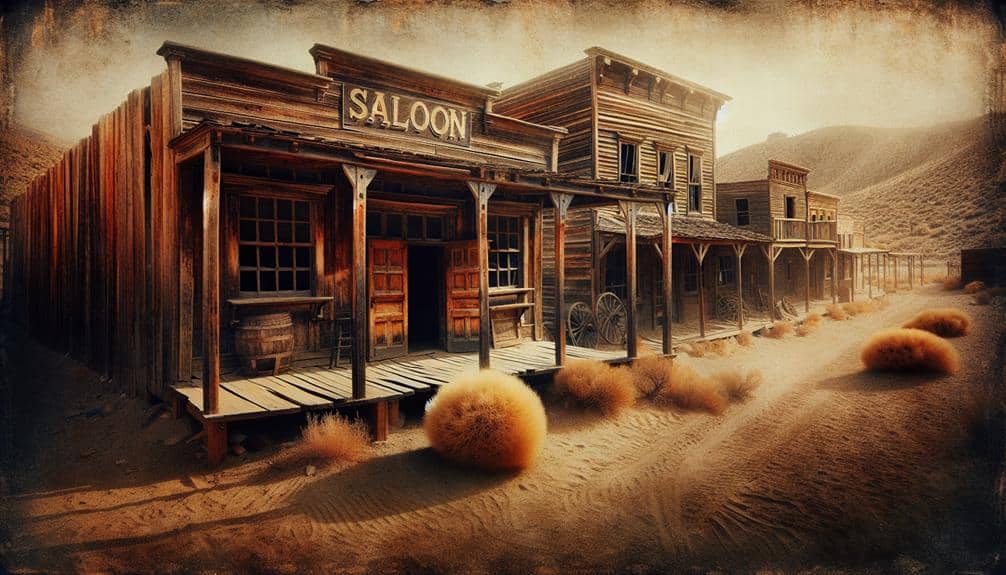When exploring old West ghost town architecture, you'll find a fascinating blend of practicality, ingenuity, and historical significance in every structure. The rugged charm reflects the frontier influences deeply embedded in these buildings. Unique aesthetics are born from salvaged materials, preserving history with environmental sustainability. Settlements adapted to harsh environments with innovative techniques like thick adobe walls and angled roofs. Pioneers fused traditional styles with innovation, adapting to extreme climate challenges. Discover how community collaboration and resourcefulness created distinctive architectural styles. Preservation efforts face challenges, but revealing these stories exposes a rich tapestry of the Old West era.
Key Points
- Architecture reflects rugged charm and historical significance.
- Use of salvaged materials for unique aesthetics and sustainability.
- Adaptation to harsh environments with innovative building techniques.
- Blend of traditional styles with frontier innovations.
- Preservation challenges include historical accuracy and financial constraints.
Influence of Frontier Settlements
The architecture of old West ghost towns reflects the rugged charm and resourcefulness of frontier settlers, showcasing a blend of practicality and ingenuity in adapting to the harsh environment. Frontier influences are deeply embedded in the structures of these towns, telling stories of resilience and survival in the face of adversity. Each building stands as a proof to the historical significance of the era, preserving a slice of the past for future generations to admire and learn from.
The design of these ghost towns captures the essence of a bygone era, where simplicity met functionality in a beautiful marriage of form and purpose. From the humble cabins to the sturdy saloons, every structure speaks of a time when life was tough but filled with a pioneering spirit that pushed settlers to create homes and businesses out of the unforgiving landscape.
As you wander through the streets of these old West ghost towns, you can't help but feel a sense of connection to the past, where every plank of wood and every nail driven into place tells a story of survival, perseverance, and the enduring spirit of those who dared to tame the wild frontier.
Use of Salvaged Materials
Incorporating salvaged materials into the construction of old West ghost town buildings not only adds character but also speaks to the resourcefulness of the settlers who repurposed items for practical use in a harsh environment. This practice contributes to the rustic charm and historical authenticity that define these unique structures.
Here's why using salvaged materials is so significant:
- Preservation of History: Salvaged materials often come from older buildings or structures, preserving a piece of history in the new construction.
- Unique Aesthetics: Each salvaged piece brings its own story and wear, adding to the overall charm and individuality of the building.
- Environmental Sustainability: Repurposing materials reduces waste and lessens the environmental impact of new construction.
- Cost-Effective: Using salvaged materials can be more affordable than purchasing new materials, making it a practical choice for settlers on a budget.
- Adaptability: Settlers had to be creative with the materials available, leading to unique design solutions that adapted to the harsh environment.
Adaptation to Harsh Environments
Utilizing innovative building techniques to withstand the unforgiving conditions of the Old West, settlers crafted structures that harmonized with the rugged landscape. Survival strategies were essential in adapting to the harsh environments prevalent in the Old West. The extreme climate conditions, including scorching heat, bitter cold, and frequent dust storms, posed significant challenges that settlers had to overcome.
To combat these challenges, settlers implemented various ingenious methods. They constructed buildings with thick adobe walls that provided insulation from both heat and cold, helping to maintain a more stable interior temperature. Additionally, many structures were built partially underground to capitalize on the earth's natural cooling properties during hot summers and insulation during cold winters.
Furthermore, the angled roofs of many buildings were designed to shed snow and rain efficiently. This design not only prevented water damage but also helped regulate indoor temperatures. By employing such survival strategies, settlers were able to create durable and functional structures that stood the test of time in the unforgiving Old West environment.
Architectural Styles and Innovations
In crafting the architecture of Old West ghost towns, settlers blended traditional styles with innovative techniques to create structures that endured the challenging environment. Architectural Styles and Innovations in these towns were influenced by various factors, resulting in unique designs that still captivate visitors today.
- Innovative Designs: Pioneers utilized locally sourced materials like adobe and timber to construct buildings that could withstand extreme weather conditions.
- Historical Influences: The architecture of Old West ghost towns reflects a mix of Native American, Spanish, and Anglo-American styles, showcasing the diverse cultural heritage of the region.
- Adaptation to Environment: Structures featured wide eaves to provide shade from the scorching sun and thick walls for insulation against the intense heat and cold nights.
- Resourcefulness: Settlers repurposed materials from abandoned mines and wagons, demonstrating a pragmatic approach to construction.
- Community Collaboration: Residents often worked together to build communal structures like churches and schools, fostering a sense of unity and resilience in the face of adversity.
Preservation Challenges
Preserving the architectural heritage of Old West ghost towns presents a complex set of challenges that require careful planning and innovative solutions. One of the primary preservation challenges is balancing restoration techniques with maintaining historical accuracy. When restoring buildings in these ghost towns, it's essential to use methods that preserve the authenticity of the structures while also guaranteeing their longevity.
Restoration techniques must be chosen wisely to prevent altering the original character of the architecture. This involves extensive research to understand the construction materials and methods used during the Old West era. Additionally, finding skilled craftsmen capable of working with traditional building techniques is vital to uphold historical accuracy.
Moreover, financial constraints often pose a significant hurdle to the preservation of Old West ghost town architecture. Securing funding for restoration projects can be challenging, especially when it involves remote locations with limited resources. Collaborating with historical preservation organizations and seeking grants can help overcome these financial obstacles and assure the continued existence of these unique architectural treasures.
Frequently Asked Questions
What Role Did Superstitions and Beliefs About the Supernatural Play in the Design of Old West Ghost Town Architecture?
When designing old west ghost town architecture, superstitions and beliefs played a significant role. Cultural influences and spiritual elements influenced the layout, incorporating folklore and paranormal aesthetics. These factors shaped a unique, eerie atmosphere that still captivates visitors today.
How Did the Presence of Outlaws and Lawlessness in the Old West Influence the Design of Ghost Town Buildings?
In designing ghost town buildings, the presence of outlaws brought about fortified structures like the jailhouse, reflecting a need for security. Supernatural beliefs influenced hidden passageways and secret rooms, catering to superstitions and providing escape routes.
Were There Any Specific Architectural Techniques Used to Create the Illusion of Ghostly Apparitions in Certain Buildings?
To create the illusion of ghostly apparitions in certain buildings, architects utilized clever illusion techniques like hidden mirrors, trap doors, and eerie lighting. These haunting designs aimed to spook visitors and add to the mysterious ambience.
How Did the Isolation and Remote Locations of Ghost Towns Affect the Overall Design and Layout of the Buildings?
How did the isolation and remote locations of ghost towns influence the design and layout of the buildings? Did the vast emptiness surrounding them inspire a sense of resilience in their sturdy structures?
Were There Any Unique Construction Methods or Building Materials Used in Order to Enhance the Eerie Atmosphere of Old West Ghost Town Architecture?
To enhance the eerie vibe of old west ghost town architecture, builders used unconventional materials like salvaged wood and corrugated metal. Construction techniques included haphazard placement of structures, adding to the mysterious and haunting atmosphere.



